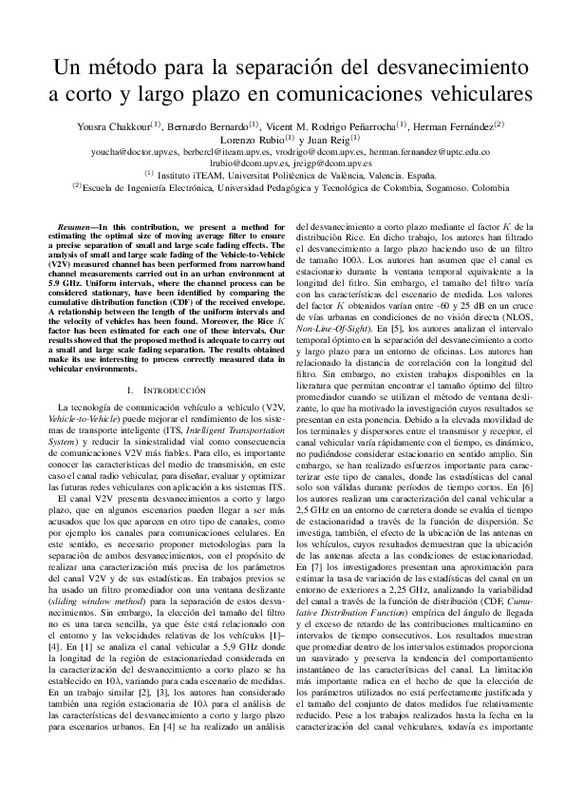JavaScript is disabled for your browser. Some features of this site may not work without it.
Buscar en RiuNet
Mi cuenta
Estadísticas
Ayuda RiuNet
Admin. UPV
Un método para la separación del desvanecimiento a corto y largo plazo en comunicaciones vehiculares
Mostrar el registro sencillo del ítem
Ficheros en el ítem
| dc.contributor.author | Chakkour, Yousra
|
es_ES |
| dc.contributor.author | Bernardo Clemente, Bernardo
|
es_ES |
| dc.contributor.author | Rodrigo Peñarrocha, Vicent Miquel
|
es_ES |
| dc.contributor.author | FERNÁNDEZ GONZÁLEZ, HERMAN ANTONIO
|
es_ES |
| dc.contributor.author | Rubio Arjona, Lorenzo
|
es_ES |
| dc.contributor.author | Reig, Juan
|
es_ES |
| dc.date.accessioned | 2021-12-20T08:39:49Z | |
| dc.date.available | 2021-12-20T08:39:49Z | |
| dc.date.issued | 2020-09-04 | es_ES |
| dc.identifier.isbn | 978-84-09-27421-5 | es_ES |
| dc.identifier.uri | http://hdl.handle.net/10251/178598 | |
| dc.description.abstract | [EN] In this contribution, we present a method for estimating the optimal size of moving average filter to ensure a precise separation of small and large scale fading effects. The analysis of small and large scale fading of the Vehicle-to-Vehicle (V2V) measured channel has been performed from narrowband channel measurements carried out in an urban environment at 5.9 GHz. Uniform intervals, where the channel process can be considered stationary, have been identified by comparing the cumulative distribution function (CDF) of the received envelope. A relationship between the length of the uniform intervals and the velocity of vehicles has been found. Moreover, the Rice K factor has been estimated for each one of these intervals. Our results showed that the proposed method is adequate to carry out a small and large scale fading separation. The results obtained make its use interesting to process correctly measured data in vehicular environments. | es_ES |
| dc.description.sponsorship | Este trabajo ha sido financiado por el Ministerio de Economía, Industria y Competitividad de España a través del proyecto TEC2017-86779-C2-2-R. | es_ES |
| dc.language | Español | es_ES |
| dc.publisher | Universidad de Málaga | es_ES |
| dc.relation.ispartof | URSI 2020. XXXV Simposium Nacional de la Unión Científica Internacional de Radio. Libro de actas | es_ES |
| dc.rights | Reserva de todos los derechos | es_ES |
| dc.subject.classification | TEORIA DE LA SEÑAL Y COMUNICACIONES | es_ES |
| dc.title | Un método para la separación del desvanecimiento a corto y largo plazo en comunicaciones vehiculares | es_ES |
| dc.type | Comunicación en congreso | es_ES |
| dc.type | Capítulo de libro | es_ES |
| dc.relation.projectID | info:eu-repo/grantAgreement/AEI/Plan Estatal de Investigación Científica y Técnica y de Innovación 2013-2016/TEC2017-86779-C2-2-R/ES/INVESTIGACION DEL CANAL RADIO PARA EL DESPLIEGUE DE SISTEMAS 5G EN UNA SOCIEDAD DIGITAL MULTICONECTADA (ICAR5G-UPV)/ | es_ES |
| dc.rights.accessRights | Abierto | es_ES |
| dc.contributor.affiliation | Universitat Politècnica de València. Instituto Universitario de Telecomunicación y Aplicaciones Multimedia - Institut Universitari de Telecomunicacions i Aplicacions Multimèdia | es_ES |
| dc.contributor.affiliation | Universitat Politècnica de València. Departamento de Comunicaciones - Departament de Comunicacions | es_ES |
| dc.description.bibliographicCitation | Chakkour, Y.; Bernardo Clemente, B.; Rodrigo Peñarrocha, VM.; Fernández González, HA.; Rubio Arjona, L.; Reig, J. (2020). Un método para la separación del desvanecimiento a corto y largo plazo en comunicaciones vehiculares. Universidad de Málaga. 1-4. http://hdl.handle.net/10251/178598 | es_ES |
| dc.description.accrualMethod | S | es_ES |
| dc.relation.conferencename | XXXV Simposium Nacional de la Unión Científica Internacional de Radio (URSI 2020) | es_ES |
| dc.relation.conferencedate | Septiembre 02-04,2020 | es_ES |
| dc.relation.conferenceplace | Online | es_ES |
| dc.relation.publisherversion | https://www.ursi.org/event.php?id=439 | es_ES |
| dc.description.upvformatpinicio | 1 | es_ES |
| dc.description.upvformatpfin | 4 | es_ES |
| dc.type.version | info:eu-repo/semantics/publishedVersion | es_ES |
| dc.relation.pasarela | S\426368 | es_ES |






